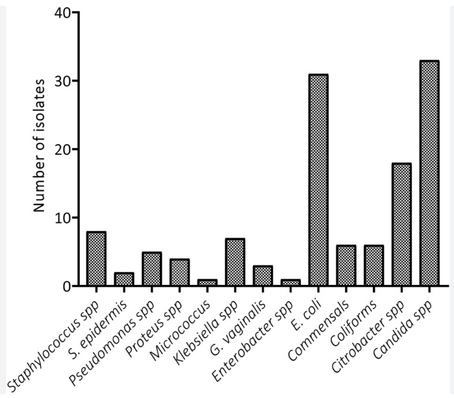Prevalence of Antibiotic Resistance Pattern of Bacterial Isolates in a Tertiary Care Hospital
Main Article Content
Abstract
The antibiogram is useful for tracking trends in antimicrobial resistance over time, including information specific to an ICU or ward or comparing inpatients and outpatients. A cumulative antibiogram will be compiled for our institution as part of our antibiotic stewardship programme. The Department of Microbiology at Santosh Medical College & Hospital in Ghaziabad, Uttar Pradesh, carried out this prospective study from January to December of 2021. Cumulative antibiograms were created using the species and their patterns of sensitivity that had been gathered. Santosh Hospital in Ghaziabad provided a total of 1395 specimens for culture and sensitivity testing; 450 (32.2%) of those samples produced a positive culture, whereas 945 (67.7%) of those samples produced no growth. It is imperative to make the best possible decision. Antibiotics balance the necessity for a wide array of empiric coverage of possible bacteria with the need to conserve effective antibiotics when they are really necessary.
Article Details
References
Joshi S. Hospital antibiogram: a necessity. Indian journal of medical microbiology. 2010 Oct 1;28(4):277-80.
Law T, Chibabhai V, Nana T. Analysis and comparison of cumulative antibiograms for the Charlotte Maxeke Johannesburg Academic Hospital adult intensive care and high-care units, 2013 and 2017. South African Medical Journal. 2020 Jan 1;110(1):55-64.
Binkley S, Fishman NO, LaRosa LA, Marr AM, Nachamkin I, Wordell D, et al. Comparison of unit-specifc and hospitalwide antibiograms: potential implications for selection of empirical antimicrobial therapy. Infect Control Hosp Epidemiol 2006;27:682-7
Daxboeck F, Assadian O, Apfalter P, Koller W. Resistance rates of Staphylococcus aureus in relation to patient status and type of specimen. J Antimicrob Chemother 2004;54:163-7.
American Thoracic Society and the Infectious Disease Society of America. Guidelines for the management of adults with hospital-acquired, ventilator-associated, and healthcare-associated pneumonia. Am J Respir Crit Care Med 2005;171:388-416.
Joshi S. Hospital antibiogram: a necessity. Indian journal of medical microbiology. 2010 Oct 1;28(4):277-80.
Bauer AW, PERRY DM, KIRBY WM. Single-disk antibiotic-sensitivity testing of staphylococci: An analysis of technique and results. AMA archives of internal medicine. 1959 Aug 1;104(2):208-16.
Sarangi KK, Pattnaik D, Mishra SN, Nayak MK, Jena J. Bacteriological profile and antibiogram of blood culture isolates done by automated culture and sensitivity method in a neonatal intensive care unit in a tertiary care hospital in Odisha, India. Int j adv med. 2015 Oct;2(4):387-92.
GHEYBI S, FAKOUR Z, KARAMYAR M, Khashabi J, Ilkhanizadeh B, ASGHARI SF, MAHMOUDZADEH H, Majlesi AH. Coagulase negative staphylococcus, the most common cause of neonatal septicemia in Urmia, Iran.
Al-Jawady Z, Al-Habib HM: Antibiogram profiles of bacterial isolates from intensive care unitsin Mosul Teaching Hospitals. Raf J Sci. 2012, 23:52-5

